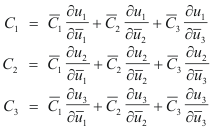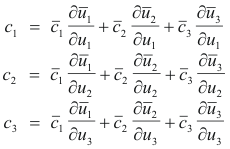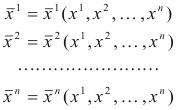
Website owner: James Miller
TENSORS, CONTRAVARIANT AND COVARIANT COMPONENTS OF A VECTOR IN A CURVINILINEAR COORDINATE SYSTEM, NOTATIONS AND ABBREVIATIONS
Contravariant and covariant components of a vector in a curvinilinear coordinate system. Suppose we are given a system of equations
u1 = u1(x, y, z)
u2 = u2(x, y, z)
u3 = u3(x, y, z)
and, the inverse transformation
x = x(u1, u2, u3)
y = y(u1, u2, u3)
z = z(u1, u2, u3)
defining a curvilinear coordinate system in space in some region R.
Contravariant components. Consider a coordinate system with its origin located at a point P in region R and with unitary base vectors

where r is the position vector of P given by
r = x(u1, u2, u3) i + y(u1, u2, u3) j + z(u1, u2, u3) k .
Then any vector A can be expressed with respect to this coordinate system in terms of its base vectors as

where C1, C2, C3 are called the contravariant components of A.
Covariant components. Consider a coordinate system with its origin located at a point P in region R and with unitary base vectors
![]()
Then any vector A can be expressed with respect to this coordinate system in terms of its base vectors as
![]()
where c1, c2, c3 are called the covariant components of A.
Question. Let A be a given vector defined with respect to two general curvilinear coordinate
systems
![]() and
and
![]() . 1. What is the relationship between the contravariant
components of A in the two systems? 2. What is the relationship between the covariant
components of A in the two systems?
. 1. What is the relationship between the contravariant
components of A in the two systems? 2. What is the relationship between the covariant
components of A in the two systems?
Answer. We answer the two questions:
1. Contravariant components. Let vector A’s contravariant components with respect to system
![]() be
be
![]() and its contravariant components with respect to system
and its contravariant components with respect to system
![]() be
be
![]() Then
Then

or more briefly
![]()
Due to symmetry, by interchanging the roles of the
![]() and
and
![]() , we see that
, we see that

These results lead us to adopt the following definition: If three quantities
![]() of a
coordinate system
of a
coordinate system
![]() are related to three other quantities
are related to three other quantities
![]() of another coordinate
system
of another coordinate
system
![]() by the transformation equations 1) or 2), then the quantities are called
components of a contravariant vector or a contravariant tensor of the first rank.
by the transformation equations 1) or 2), then the quantities are called
components of a contravariant vector or a contravariant tensor of the first rank.
2. Covariant components. Let vector A’s covariant components with respect to system
![]() be
be
![]() and its covariant components with respect to system
and its covariant components with respect to system
![]() be
be
![]() Then
Then

or more briefly
![]()
Due to symmetry, by interchanging the roles of the
![]() and
and
![]() , we see that
, we see that
![]()
These results lead us to adopt the following definition: If three quantities
![]() of a
coordinate system
of a
coordinate system
![]() are related to three other quantities
are related to three other quantities
![]() of another coordinate
system
of another coordinate
system
![]() by the transformation equations 3) or 4), then the quantities are called
components of a covariant vector or a covariant tensor of the first rank.
by the transformation equations 3) or 4), then the quantities are called
components of a covariant vector or a covariant tensor of the first rank.
In generalizing these concepts to higher dimensions and in generalizing the concept of vector we are lead to tensor analysis.
Notations and abbreviations of tensor analysis
Notations for variables. In tensor analysis we use both superscripts and subscripts in denoting variables. We may refer to a set of variables x1, x2, ..., xn or to the set of variables x1, x2, ..., xn .
Notations for coordinate transformations. Let
![]() and
and
![]() be the coordinates of a point with respect to two different frames of reference and
suppose a transformation of coordinates is defined between the two frames of reference by the
system
be the coordinates of a point with respect to two different frames of reference and
suppose a transformation of coordinates is defined between the two frames of reference by the
system

This system can be denoted by the shorthand notation
![]()
There will then be an inverse transformation given by
![]()
The summation convention. The summation convention is the convention of letting the repetition of an index (subscript or superscript) in a given term denote a summation with respect to that index over its range. For example, the sum
a1x1 + a2x2 + ... + anx6
is denoted by the shorthand notation aixi. Instead of using the index i in this example we could have used another letter, say q, and the sum could be written aqxq. A repeated index, such as i in aixi, is called a dummy index of umbral index.
Free index. An index that occurs only once in a given term is called a free index. A free index stands for any of the numbers 1, 2, ... , n. An example is k in the equations 5) and 6) above.
Contravariant tensor of the first rank (or first order). If n quantities
![]() in a coordinate system
in a coordinate system
![]() are related to n other quantities
are related to n other quantities
![]() in another coordinate system
in another coordinate system
![]() by the transformation equations
by the transformation equations

or, by the conventions and abbreviations we have adopted,

they are called components of a covariant tensor of the first rank (or first order). [they may also be called components of a contravariant vector]
Covariant tensor of the first rank (or first order). If n quantities
![]() in a coordinate system
in a coordinate system
![]() are related to n other quantities
are related to n other quantities
![]() in another coordinate system
in another coordinate system
![]() by the transformation equations
by the transformation equations
![]()
or, by our conventions,
![]()
they are called components of a covariant tensor of the first rank (or first order). [they may also be called components of a covariant vector]
Subscript and superscript conventions. Superscripts are used to indicate contravariant components. Subscripts are used to indicate covariant components. Either subscripts or superscripts can be used for coordinates.
Note. Instead of speaking of a tensor whose components are Ap or Ap we often refer simply to the tensor Ap or Ap.
Contravariant tensor of the second rank. If n2 quantities
![]() in a coordinate
system
in a coordinate
system
![]() are related to n2 other quantities
are related to n2 other quantities
![]() in another coordinate system
in another coordinate system
![]() by the transformation equations
by the transformation equations
![]()
or, by our conventions,
![]()
they are called components of a contravariant tensor of the second rank (or of rank two).
Note. The tensors
![]() and
and
![]() are two dimensional arrays containing n rows and n columns.
The integers p, r and q, s are row and column indices pointing to elements within the arrays. We
can speak of a tensor
are two dimensional arrays containing n rows and n columns.
The integers p, r and q, s are row and column indices pointing to elements within the arrays. We
can speak of a tensor
![]() (tensor array) or we can speak of an element within the tensor, say
(tensor array) or we can speak of an element within the tensor, say
![]() or
or
![]() . Thus we use the same notation for both the tensor and elements within the tensor, a
possible cause for confusion. These arrays represent a generalization of the concept of a vector
leading into tensor analysis.
. Thus we use the same notation for both the tensor and elements within the tensor, a
possible cause for confusion. These arrays represent a generalization of the concept of a vector
leading into tensor analysis.
Covariant tensor of the second rank. If n2 quantities
![]() in a coordinate
system
in a coordinate
system
![]() are related to n2 other quantities
are related to n2 other quantities
![]() in another coordinate system
in another coordinate system
![]() by the transformation equations
by the transformation equations
![]()
or, by our conventions,
![]()
they are called components of a covariant tensor of the second rank.
Mixed tensor of the second rank. If n2 quantities
![]() in a coordinate
system
in a coordinate
system
![]() are related to n2 other quantities
are related to n2 other quantities
![]() in another coordinate system
in another coordinate system
![]() by the transformation equations
by the transformation equations
![]()
or, by our conventions,
![]()
they are called components of a mixed tensor of the second rank.
Tensors of rank greater than two. Tensors of rank greater than two are easily
defined. For example, the tensor
![]() , a mixed tensor of rank 5, contravariant of order 3 and
covariant of order 2, is defined by the following relation
, a mixed tensor of rank 5, contravariant of order 3 and
covariant of order 2, is defined by the following relation

Note the pattern of the indices in the successive fractions

Each index of
![]() is paired with its counterpart in
is paired with its counterpart in
![]() i.e. p is paired with q, r is paired with
s, m is paired with t, etc. The order of the fractions is the same as the order of the indices in
i.e. p is paired with q, r is paired with
s, m is paired with t, etc. The order of the fractions is the same as the order of the indices in
![]() i.e. p, r, m, i, j. The covariant fractions are the same as the contravariant fractions, but
inverted.
i.e. p, r, m, i, j. The covariant fractions are the same as the contravariant fractions, but
inverted.
References.
Spiegel. Vector Analysis. Chap. 7, 8.
Jesus Christ and His Teachings
Way of enlightenment, wisdom, and understanding
America, a corrupt, depraved, shameless country
On integrity and the lack of it
The test of a person's Christianity is what he is
Ninety five percent of the problems that most people have come from personal foolishness
Liberalism, socialism and the modern welfare state
The desire to harm, a motivation for conduct
On Self-sufficient Country Living, Homesteading
Topically Arranged Proverbs, Precepts, Quotations. Common Sayings. Poor Richard's Almanac.
Theory on the Formation of Character
People are like radio tuners --- they pick out and listen to one wavelength and ignore the rest
Cause of Character Traits --- According to Aristotle
We are what we eat --- living under the discipline of a diet
Avoiding problems and trouble in life
Role of habit in formation of character
Personal attributes of the true Christian
What determines a person's character?
Love of God and love of virtue are closely united
Intellectual disparities among people and the power in good habits
Tools of Satan. Tactics and Tricks used by the Devil.
The Natural Way -- The Unnatural Way
Wisdom, Reason and Virtue are closely related
Knowledge is one thing, wisdom is another
My views on Christianity in America
The most important thing in life is understanding
We are all examples --- for good or for bad
Television --- spiritual poison
The Prime Mover that decides "What We Are"
Where do our outlooks, attitudes and values come from?
Sin is serious business. The punishment for it is real. Hell is real.
Self-imposed discipline and regimentation
Achieving happiness in life --- a matter of the right strategies
Self-control, self-restraint, self-discipline basic to so much in life